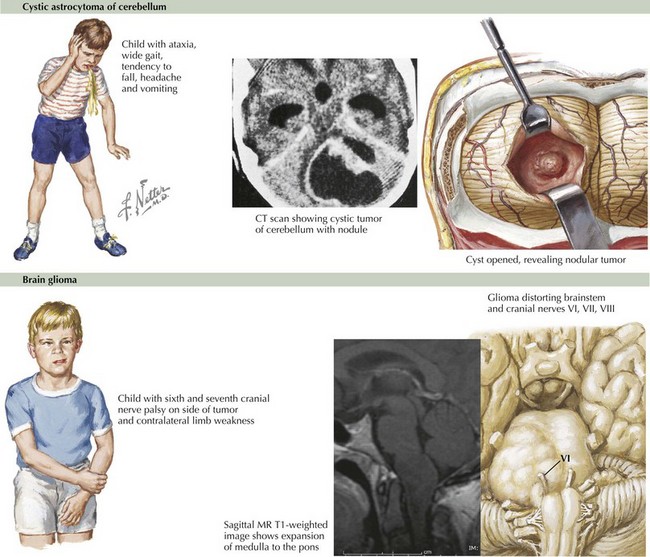57 Brain Tumors
Clinical Presentation
The presenting symptoms of a brain tumor are determined by tumor location rather than histology. Brain tumors may present with either generalized or localizing symptoms. Generalized symptoms are caused by obstruction of cerebrospinal fluid (CSF) with associated hydrocephalus and increased intracranial pressure (ICP). Increased ICP is more common with fourth ventricular or posterior fossa, pineal, suprasellar, and tectal tumors. Symptoms include headache (particularly in the morning), nausea, vomiting, and fatigue. On examination, paresis of upgaze, sixth cranial nerve palsies, and papilledema are often seen. In infants, macrocephaly, tense fontanelle, failure to thrive, developmental delay, and paresis of upgaze with downward eye deviation (“sun setting”) are common. Posterior fossa tumors, such as cerebellar astrocytomas, often present with increased ICP (Figure 57-1).
Localizing symptoms depend on tumor location. Cerebellar tumors commonly present with ataxia and dysmetria. Brainstem tumors may cause cranial nerve deficits (diplopia, facial weakness, swallowing deficits), unsteadiness, and weakness (see Figure 57-1). Symptoms from hemispheric cortical tumors include seizures, hemiparesis, visual field deficits, and changes in behavior or school performance. Tumors in the suprasellar region often present with bitemporal visual field loss, decreased acuity, and hormonal dysfunction. Pineal region tumors frequently compress the tectal region of the brainstem and result in Parinaud’s syndrome, characterized by paresis of upgaze, convergence nystagmus, pupils that respond better to accommodation than light (light-near dissociation), and eyelid retraction. Tumors of the spinal cord (primary or metastatic) may cause back pain, extremity weakness, sensory dysfunction, and bowel or bladder dysfunction. The most common presenting signs and symptoms are outlined in Table 57-1.
Table 57-1 Signs and Symptoms Associated with Intracranial Tumors
< div class='tao-gold-member'> Only gold members can continue reading. Log In or Register to continue
Stay updated, free articles. Join our Telegram channel
Full access? Get Clinical Tree
 Get Clinical Tree app for offline access
Get Clinical Tree app for offline access

|
